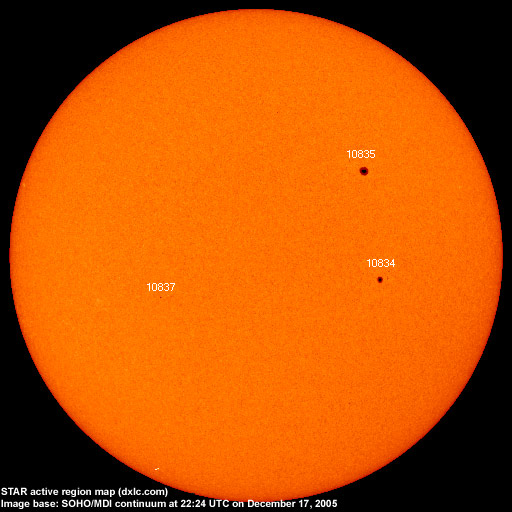

Last major update issued on December 18, 2005 at 04:55 UTC.
[Solar
and
geomagnetic data - last month (updated daily)]
[Solar
wind and
electron fluence charts (updated daily)]
[Solar
cycles 21-23
(last update December 6, 2005)]
[Solar
cycles 1-20]
[Graphical
comparison
of cycles 21, 22 and 23 (last update December 6, 2005)]
[Graphical
comparison of cycles 2, 10, 13, 17, 20 and 23 (last update December 6,
2005)]
[Historical
solar and
geomagnetic data charts 1954-2004 (last update February 1, 2005)]
[Archived
reports
(last update December 3, 2005)]
The geomagnetic field was very quiet to quiet on December 17. Solar wind speed ranged between 304 and 354 (all day average 336) km/sec.
Solar flux measured at 20h UTC
on 2.8 GHz was 85.2. The planetary
A
index was 5 (STAR Ap - based on the mean of three hour interval ap
indices: 4.8).
Three hour interval K indices: 01122101 (planetary), 01233320 (Boulder).
The background x-ray flux is at the class A5 level.
At midnight there were 3 spotted regions on the visible solar disk. The solar flare activity level was very low. No C class events were recorded during the day.
Region 10834 decayed slowly and quietly.
Region 10835 decayed slowly and was quiet.
New region 10837 emerged in the southeast quadrant. The region decayed during the last quarter of the day and could soon
become spotless again.
December 15-17: No obvious partly or fully Earth directed CMEs were observed in incomplete imagery.
Coronal
hole
history (since late October 2002)
Compare today's report with the
situation one solar rotation ago: 28
days ago 27 days ago 26
days ago
No obvious coronal holes are currently in or near Earth facing positions.

Processed SOHO/EIT 284 image at 13:06 UTC on December 2. The darkest areas on the solar disk are likely coronal holes.
The geomagnetic field is expected to be mostly quiet on December 18-22.
| Coronal holes (1) | Coronal mass ejections (2) | M and X class flares (3) |
1) Effects from a coronal hole could reach
Earth
within the next 5 days. When the high speed stream has arrived
the color changes to green.
2) Material from a CME is likely to impact Earth within 96 hours.
3) There is a possibility of either M or X class flares within the next
48 hours.
Green: 0-20% probability, Yellow: 20-60% probability, Red: 60-100% probability.
Long distance low and medium frequency (below 2 MHz) propagation along east-west paths over high and upper middle latitudes is good. Propagation on long distance northeast-southwest paths is very poor. Trans Atlantic propagation conditions are normally monitored every night on 1470 kHz. Dominant station tonight: WLAM Lewiston ME. Many stations from North America were heard throughout the MW band. WJR Detroit on 760 and WHAS Louisville on 840 kHz both had good signals, just two examples of which stations could be heard.

Compare to the previous day's image.
Data for all numbered solar regions according to the Solar Region Summary provided by NOAA/SEC. Comments are my own, as is the STAR spot count (spots observed at or inside a few hours before midnight) and data for regions not numbered by SEC or where SEC has observed no spots. SEC active region numbers in the table below and in the active region map above are the historic SEC/USAF numbers.
| Active region | Date numbered | SEC spot count |
STAR spot count |
Location at midnight | Area | Classification | Comment |
|---|---|---|---|---|---|---|---|
| 10834 | 2005.12.09 | 7 | 4 | S07W32 | 0110 | DAI | classification was CSO at midnight, area 0060 |
| 10835 | 2005.12.09 | 4 | 1 | N19W27 | 0110 | DSO | classification was HAX at midnight |
| 10837 | 2005.12.17 | 4 | 1 | S10E22 | 0020 | DSO | classification was AXX at midnight, area 0010 |
| S613 | 2005.12.12 | S08W14 | plage | ||||
| Total spot count: | 15 | 6 | |||||
| SSN: | 45 | 36 | |||||
| Month | Average solar flux at Earth |
International sunspot number | Smoothed sunspot number |
|---|---|---|---|
| 2000.04 | 184.2 | 125.5 | 120.8 cycle 23 sunspot max. |
| 2000.07 | 202.3 | 170.1 | 119.8 |
| 2001.12 | 235.1 | 132.2 | 114.6 (-0.9) |
| 2004.10 | 105.9 | 48.0 | 35.9 (-1.6) |
| 2004.11 | 113.2 | 43.5 | 35.3 (-0.6) |
| 2004.12 | 94.5 | 17.9 | 35.2 (-0.1) |
| 2005.01 | 102.2 | 31.3 | 34.6 (-0.6) |
| 2005.02 | 97.2 | 29.2 | 33.9 (-0.7) |
| 2005.03 | 89.9 | 24.5 | 33.5 (-0.4) |
| 2005.04 | 86.0 | 24.4 | 31.6 (-1.9) |
| 2005.05 | 99.3 | 42.6 | 28.9 (-2.7) |
| 2005.06 | 93.7 | 39.6 | (28.1 predicted, -0.8) |
| 2005.07 | 96.4 | 39.9 | (27.6 predicted, -0.5) |
| 2005.08 | 90.5 | 36.4 | (25.7 predicted, -1.8) |
| 2005.09 | 91.1 | 22.1 | (23.6 predicted, -2.1) |
| 2005.10 | 77.0 | 8.5 | (21.6 predicted, -2.0) |
| 2005.11 | 86.3 | 18.0 | (19.2 predicted, -2.4) |
| 2005.12 | 91.6 (1) | 33.2 (2) | (16.4 predicted, -2.8) |
1) Running average based on the
daily 20:00 UTC observed solar flux
value at 2800 MHz.
2) Unofficial, accumulated value based on the Boulder (NOAA/SEC)
sunspot number. The official international sunspot number is typically
30-50% lower.
This report has been prepared by Jan Alvestad. It is based partly on my own observations and analysis, and partly on data from some of these solar data sources. All time references are to the UTC day. Comments and suggestions are always welcome.
| [DX-Listeners' Club] |